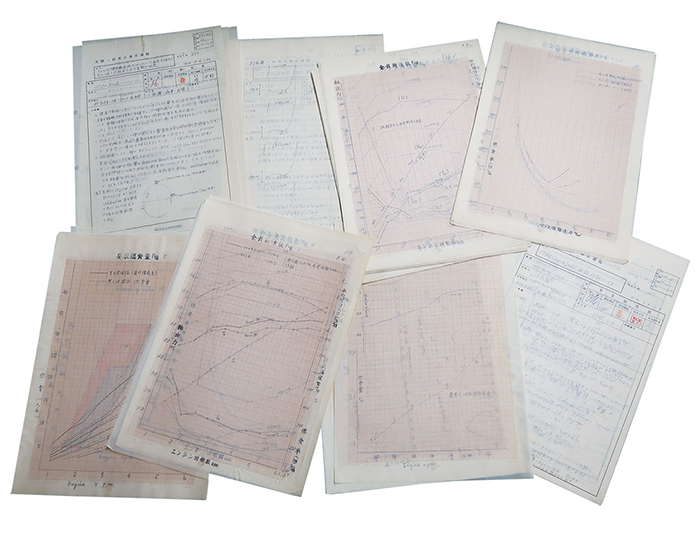passed down through the ages
“We may be unable to bring out a next-generation rotary engine if this goes on.”
At the beginning of the 1990s, development staff members found themselves in tough position when their two-year long research came to a complete impasse. It was extremely important research aimed at developing new technology that would significantly improve the fuel economy and environmental performance of rotary engines (REs) to see them through to the next age. REs were a symbol of Mazda’s technology since they were successfully put to practical use in the Cosmo Sport in 1967, but they were now on the verge of disappearing forever. “That's just not possible! We can still resolve this.” an engineer exclaimed standing up to the potential demise of REs. “If we end the development of REs now, all the research that we have accumulated until now might as well all go to waste.” he said firmly. As he had greatly contributed to the development of REs so far, he was confident in his abilities and believed that his idea would become the decisive factor in overcoming the difficulties they were facing.
Volunteering to be leader of the development team, he resumed the development of REs with staff members he handpicked himself, advocating the idea of a revolutionary air intake and exhaust system that could not only improve the fuel economy and exhaust gas cleaning performance of REs but also reduce their cost. However, an unexpected challenge awaited them. Although as predicted, they were able to achieve revolutionary performance improvements for primary prototype engines, the situation was not looking good for secondary prototype engines, which required a perfect balance of power output, fuel efficiency, and durability. Consequently, the team became unable to reach their expected results.
The lead engineer’s unwavering confidence began to dwindle. Day in and day out he was absorbed in his thoughts searching for a way out of this situation. Growing desperate, he started avidly reading old materials in search for the solution to the problem and found an abundance of carefully organized development records among them. The records were left behind by their great predecessors who persevered for as long as six years during an unforgivably competitive era to succeed in commercializing REs.
Of course, some of the contents fell short of current technical standards since the records were written several decades ago. However, what was most surprising was the organization of the contents. Scrupulous records were kept about individual technical problems at the time, including development processes, considerations, and future countermeasures. The records were carefully written in a finely polished manner, using many handwritten charts, as if the author had known that they would be read by junior colleagues working on a development project two decades or so later. More surprising perhaps, was that they were written in times when there were no convenient tools, such as personal computers and dedicated software — unlike today. The lead engineer admired the foresight of his predecessors, and at the same time, was ashamed of himself for paying little to no attention to junior colleagues. These records greatly inspired him, and he promised himself that he would complete the development of the next-generation rotary engine.
After overcoming numerous challenges, he and his team finally succeeded in developing a new rotary engine. Made using cutting edge technology, the new rotary engine not only paved the way to the next generation of REs but also received such high acclaim that it was selected as the International Engine of the Year. This was an outstanding achievement and the best thing that could ever happen to a vehicle engineer.
There was another unforgettable event that supported their success. When they hit rock bottom with no prospects for future development, they met with Kenichi Yamamoto, a former employee. He was a leading expert in the development of REs at Mazda, who once devoted all his time to research aimed at implementing REs for practical use. Since the team felt completely cornered with no solution in sight, they were hoping to be lectured by Yamamoto, the father of rotary engines. However, Yamamoto did not offer harsh words at all, but rather showed his appreciation for their hard work with a smile. “You seem to be experiencing more hardships than we did.” he said. “Amid all of our struggles, we were saved by his compassionate words.” later said the lead engineer, reminiscing about the past.
There was no model or book to copy from for the RE they developed, it was the first of its kind in the world. Despite feelings of helplessness, the development team had to clutch on to whatever they could to fight their way through this uphill battle. However, worldwide reverberations, high praise, and, particularly, an enormous sense of achievement awaited them after everything they went through. The team recalled their whole path, remembering the days of hardship and realized that they had come close to the engineers led by Yamamoto that they admired. This realization filled the team with a sense of pride stronger than any medal that they could have received. It was a gamble of a lifetime, that fortunately ended in pure bliss and unparalleled delight for the engineers.

Origin of the name "RENESIS"
RENESIS named International Engine of the Year
The winners are selected by renowned motoring journalists from around the world and for 2003, Mazda's new-generation rotary engine won the "Best New Engine of 2003" special award as well as the"2.5-litre to 3-litre" capacity class award. Each engine that wins the prize for each of the eight engine capacity classes are automatically shortlisted for the International Engine of the Year award. In 2003, the RENESIS was chosen as the overall winner and received the award.
Furthermore, in 2004, the engine was named the "2.5-litre to 3-litre" capacity class award for the second year running.